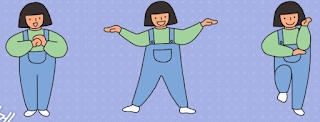This week's Article: sarah-marie belcastro & Karl Shaffer (2011). Dancing mathematics and the mathematics of dance.
I enjoyed watching Malke Rosenfeld's TedX video, "Jump into Math," where she discussed the importance of patterns in math, highlighting the strong connection between mathematics and dance. While learning to dance, individuals not only develop physical skills but also gain insights into mathematical concepts, particularly in geometry. Rosenfeld's emphasis on ensuring dance synchronization with a partner to understand transformations and symmetry resonated with me as a valuable approach to make mathematics more tangible.
In the article by Sarah-Marie Belcastro and Carl Shaffer (2011), they underscored the parallels between dance movements and mathematical concepts. My first stop in this article was when many dancers performed symmetrical patterns in movements. This resonated with Rosenfeld's emphasis on symmetry in dance. My second stop was exploring the strong relationship between geometry and dance, where dancers utilized various tools like ropes or ribbons to form shapes. By observing dancers moving their bodies in different directions, it became evident how these movements connected to the principles of geometry. This article provided practical activities and challenges for integrating body movements into mathematics learning, becoming my second stop in this insightful exploration.
Reflecting on our first graders, who thrive on physical engagement, I recalled an activity where we transformed the playground into a giant number line, fostering their interest and participation in addition and subtraction. The dynamic blend of movement and mathematics proved more engaging than traditional paper-based approaches.
After absorbing insights from the video and article, I'm pondering questions about incorporating more movement-based approaches, like dance, into our math lessons. Considering my upcoming math inquiry on time, I'm exploring activities that merge movement with temporal concepts. Additionally, I'm contemplating ways to be mindful in connecting mathematics and dance, seeking simple and practical steps for immediate implementation.
Reflective Questions:
- How can I implement more movement-based approaches, such as dance, in mathematics learning?
- What are some possible activities to explore in my next math inquiry on time?
- How can I be more mindful in making connections between mathematics and dance?
- What are simple and easy steps I can take immediately to enhance the integration of movement in math lessons?
For this week's engaging activity, I introduced the Clap Hands body-rhythm pattern game to my first graders during our morning meeting. Regrettably, I couldn't capture the lively moments as I didn't have my co-teacher present for recording or photos. Nevertheless, the experience was thoroughly enjoyable and fascinating as I observed the students' diverse movements challenging one another. While some required additional guidance to grasp the rules, the overall engagement and focus were noteworthy.
This activity brought to mind a game from my past experiences in Korea known as "Di-Be-Di-Be-Deep." In this game, participants engage in three specific body movements, with the player and the "it" selecting one movement after the chant "Di-Be-Di-Be-Deep!"—similar to the concept of rock, paper, scissors. If the player matches the chosen movement of the "it," they lose. This game not only adds a fun element but also encourages students to think strategically about their movements to outsmart the "it."
Belcastro, S.-M., & Shaffer, K. (2011). Dancing mathematics and the mathematics of dance.






Incorporating time and movement immediately takes me back to my childhood watching The Big Comfy Couch! Last year, I had my students lie on the floor and act like a clock to display times using markers I had placed. It's such a natural lesson to include movement if you had that television experience growing up!! Thank you for sharing your activity from Korea as well; I have never heard of that game and would love to give it a try with my kids.
ReplyDeleteUntil reading your post, I had no idea that there were so many inherent parallels between math and dance. This is surprising, considering one of my favourite Olympic events is rhythmic gymnastics! Forming shapes while dancing is such a great way to incorporate art with math and make the subject meaningful while engaging the entire body. Thank you so much for sharing!